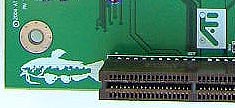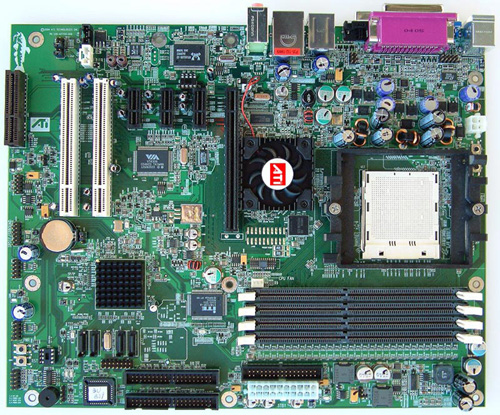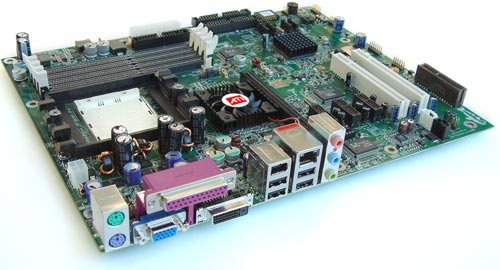ATI Radeon Xpress 200: Performance, PCI Express & DX9 for Athlon 64
by Wesley Fink on November 8, 2004 6:00 AM EST- Posted in
- CPUs
ATI Bullhead Reference Board: Basic Features
ATI calls their new ATI RX480 Reference Board the "Bullhead", and it even carries a logo of a Bullhead fish on the motherboard.
The Bullhead is an extremely wide-ranging variety of fish related to channel catfish. There is probably a lot more to the story.
| ATI RS480 Reference Board Specifications | |
| CPU Interface | Socket 939 Athlon 64 |
| Chipset | RS480/SB400 |
| Bus Speeds | 200MHz to 320MHz |
| PCI Express Speeds | PCIe FIX at 100MHz to 200MHz (in 1MHz increments) |
| Core Voltage | 1.0V to 1.7V in 0.025V increments |
| CPU Clock Multiplier | 4X-25.5X in 0.5X increments |
| CPU Auto Tuning | Off to 15% in 1% increments |
| HyperTransport Frequency | 1000MHz (1GHz) |
| HyperTransport Multiplier | 1X, 2X, 4X, 5X |
| DRAM Voltage | 2.6V, 2.85V |
| AGP Voltage | None available on Reference Board |
| HyperTransport Voltage | None available on Reference Board |
| Memory Slots | Four 184-pin DDR DIMM Slots Dual-Channel Configuration Regular Unbuffered Memory to 4GB Total |
| Expansion Slots | 1 x16 PCIe Slot 3 x1 PCIe Slots 2 PCI Slots 1 Dedicated Communications Riser |
| Onboard SATA/SATA RAID | 4 Drives by SB400 (RAID 0, 1) |
| Onboard IDE/IDE RAID | Two Standard ATA133/100/66 (4 drives) |
| Onboard USB 2.0/IEEE-1394 | 8 USB 2.0 ports supported by SB400 2 Firewire 1394A by VIA VT6306 |
| Onboard LAN | 1Gigabit Ethernet by Realtek 8110S-32 |
| Onboard Audio | AC '97 2.3 8-Channel by Realtek ALC655 |
| BIOS Revision | AMI AMBU-B10 11/02/2004 |
The ATI Bullhead Reference Board is truly unique among the Reference boards that we have tested. Normally, the Reference Board is devoid of BIOS adjustments and overclocking controls that may later appear on boards designed with the Reference chipset. The ATI Bullhead, on the other hand, is loaded with a huge range of controls that will make any enthusiast happy. It is very clear that ATI's goal was to demonstrate, on the front end, that their new chipset for AMD Athlon 64 can hold its own against any competition in the market. Given the enthusiast orientation of some other chipsets for Athlon 64, this was a very smart move by ATI. While ATI is well-known in the OEM market, this attention to flexible ranges and useful overclocking controls announces to the market that ATI intends to be a serious player in the Athlon 64 enthusiast arena.
As a result of the attention that ATI has lavished on the Bullhead, we have the capabilities of testing the overclocking capabilities and memory stress testing that are normally not possible with a Reference design.

The ATI Bullhead is generally very well laid out - much better than we normally see in Reference boards. The power connectors are in the best position on board edges to ease power cable routing. The Hard Disks and SATA locations are reasonable. Even the floppy connector is in a better mid-board location instead of the bottom location that creates a challenge on many new boards. Manufacturers would do well to copy the ATI Bullhead Reference design. No board is perfect in layout, but the Bullhead is very easy to work with in most cases.

ATI also included a full range of IO ports on the Bullhead Reference board. Additional audio connectors are available on a port header in the dedicated CNR slot. The range of options and ports is unusually complete for a Reference board. Once again, the Reference design is worth copying by manufacturers. Perhaps ATI realized that without the chipset history of nVidia or VIA, they would have to work harder to get the market to take ATI seriously as a chipset option. One clever way to accomplish that is to deliver a Reference board that can be put into production by manufacturers without much, if any, redesign. It works for graphics cards, and it can certainly also work for motherboards.










45 Comments
View All Comments
Sahrin - Monday, November 8, 2004 - link
I'm really excited to see another performance player in the AMD chipset market. Ironically, despite the fact that Intel is considered to have the best quality chipsets, the AMD segment has the most players and the most options. This chipset looks very good to me, especially as an overclocker, but I'm kind of left hanging in the feature set, which traditionally has been the determinant in the A64 market. Sure, 6 SATA ports is nice...etc. etc. but where's my dual integrated GigE LAN? I will take a long hard look at this chipset if SB450 comes out in time, but I think I will likely be going nForce one more generation.SLIM - Monday, November 8, 2004 - link
#6, of course you use an FX with the best gfx card available, he's trying to highlight small differences between chipsets. If you want P4 vs A64 look at a recent cpu review.However one large set of differences were the specviewperf benches? Huge differences when using ati/ati (some good and some bad) but no comments as to wtf is going on. Are those differences related to DX vs opengl, other driver issues, anybody know??
ipoh - Monday, November 8, 2004 - link
Onboard graphics use to be not good but changed since ATi comes out with RS350...and with this RS480 DX9 VGA will be definitely goodCurrently using my RS350 playing Doom3 and still looks good :)
I will spend my money for more HDD :)
Ivo - Monday, November 8, 2004 - link
With DX9 included, the integrated graphics (IG) of RS480 is good. First of all, with guaranteed future OS compatibility, it's very good for the OEM - for both business machines and home-office PCs. Secondly, as stated it the review, it is good enough for high-end 2D users because of the Surround View option. Third, it is a reasonable option for gamers too, as it could serve in emergency cases, when your high-end overclocked graphic card is tired ;-(The IG could be even more interesting for occasional gamers and even business users if, in a thinkable upcoming chipset, the IG is involved in a SLI scheme with one graphic card. In that case the IG will add it's modest 10% to 20% to the overall gaming performance (small, but from heart). This 10%-20% could be interesting for the real gamers too, if the IG is involved in a triple SLI scheme with two additional graphic cards.
My questions to this great article are:
1. What about the Cool 'N Quiet operation - does it work properly on the reference board with all (DIMM etc.) configurations used?
2. What is ATI suggesting about the SidePort - why it is limited to 32 bit and 16MB only?
byvis - Monday, November 8, 2004 - link
It's very impressive. But I have one minor question about the benchmarking. Why didn't you test Nforce4 + X800XT in Winstone and other benchmarks? I see, that you DID test RX480 + GF6800U and RX480 + X800XT. Maybe the margins are very small, but I'd like to see them, I think other people would like that too.deathwalker - Monday, November 8, 2004 - link
ATI might be right in the thick of it based on performance..however...from a marketing standpoint I think they will have a tough road to plow.bearxor - Monday, November 8, 2004 - link
SoldJalf - Monday, November 8, 2004 - link
Onboard graphics makes perfect sense for non-gamers.If they can cram in something that works for normal desktop use, *and* can claim to support DirectX 9 as well, then it's a pretty good deal. It'll serve your needs under normal use, and it'll at least be able to run games, even if they might get an unplayable framerate.
DrDisconnect - Monday, November 8, 2004 - link
I'm surprised that any of you are wondering why they are producing an integrated graphics versio. Haven't you taken a walk through any of the computer superstores lately? Entry level machines from HP etc. are using integrated graphics to hold prices down yet allow users to beef up their machines when they ahve some coin later on.ranger203 - Monday, November 8, 2004 - link
-1st of all, why does anandtech keep benchmarking AMD FX chips, sure they are the fastest hands down, but none of us are buying they. I.e. they are comparing apples to oranges, (FX vs. P4). They need to bench regular A64s!!!!-2nd, Onboard video still really sucks for gaming, but atleast they are making an effort, they should relize that $30 gaming cards are better quality than their onboard video and stop integrating it into their full size atx boards!!! Unless this was just a "show" board of ati's capability, then i could understand....